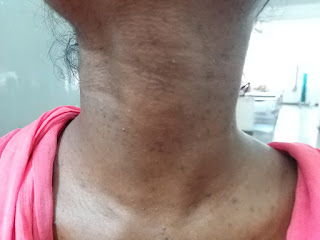CASE 1
https://swathibogari158.blogspot.com/2020/09/chronic-decompensated-liver-disease.html
Q1 Reason for this patients ascites :
The most common cause of Ascites is
Cirrhosis of liver
risk factors in this patient :
1. Chronic alcoholism since 40 years
2. Truncal obesity leading to metabolic syndrome causing NAFLD leading to cirrhosis
https://www.ncbi.nlm.nih.gov/pmc/articles/PMC6092576/
Altered echo texture of liver due to Cirrhosis causes portal hypertension leading to increased hydrostatic pressure causing fluid accumulation hence Ascites
2) Why did the patient develop bipedal lymphedema? What was the reason for the recurrent blebs and ulcerations and cellulitis in his lower limbs?
Ans. Bilateral pedal oedema may be due to the decrease in the levels of albumin (long standing cirrhosis).
The ulcerations are due to limited movements (improper dressings).
3) What was the reason for his asterixis and constructional apraxia and what was done by the treating team to address that?
Ans:-Hepatic encephalopathy,
pathophysiology of HE
1 role of neurotoxins,
2.impaired neurotransmission due to metabolic changes in liver failure, changes in brain energy metabolism, systemic inflammatory response and alterations of the blood brain barrier which produces a wide spectrum of nonspecific neurological and psychiatric manifestations
the treating team gave -
lactulose and rifaximin
underlying mechanism of Giving lactulose
1.First, the colonic metabolism of sugars causes a laxative effect via an increase in intraluminal gas formation and osmolality which leads to a reduction in transit time and intraluminal pH. This laxative effect is also beneficial for constipation.
2. lactulose promotes increased uptake of ammonia by colonic bacteria which utilize the trapped colonic ammonia as a nitrogen source for protein synthesis. The reduction of intestinal pH facilitates this process, which favors the conversion of ammonia (NH3) produced by the gut bacteria, to ammonium (NH4+),an ionized form of the molecule, unable to cross biological membranes.
3. lactulose also causes a reduction in intestinal production of ammonia. The acidic pH destroys urease-producing bacteria involved in the production of ammonia. The unabsorbed disaccharide also inhibits intestinal glutaminase activity, which blocks the intestinal uptake of glutamine.
4) What was the efficacy of each treatment intervention used for this patient? Identify the over and under diagnosis and over and under treatment issues in the management of this patient.
Ans.
A. high protein diet (2eggs / day) for decreased albumin synthesis
B. Air or water bed to prevent pressure bed sores in the dependent areas
C. Fluid restriction <1.5litres/day so as to decrease of fluid dissemination into the extra vascular space
D. Salt restriction <2.4gms/day to prevent retention of water.
E. Inj augmentin 1.2gm IV/BD to prevent secondary bacterial infections
F. Inj pan 40 mg IV/OD
G. Inj zofer 4mg IV/BD
H. Tab. Lasilactone (20/50)mg BD ( combination of furosemide and aldactone to decrease pedal oedema
If SBP <90mmhg - to avoid excessive loss of fluid
I. Inj vit k 10mg IM/ STAT ( as vitamin K causes coagulation to further prevent bleeding manifestions
J. Syp lactulose 15ml/PO/BD for hepatic encephalopathy
K. Tab udiliv 300mg/PO/BD contain Ursodeoxycholic acid as an active ingredient. It is used to dissolve gall stones in various liver-related disorders such as cirrhosis
L. Syp. Hepameiz 15 ml/PO/OD
M. IVF 1 NS slowly at 30ml/hr to maintain hydration
N. Inj thiamine 100mg in 100mlNS /IV/TID as thiamine deficiency's occur in chronic alcoholics
O. Strict BP/PR/TEMP/Spo2 CHARTING HOURLY
P. Strict I/O charting
Q. GRBS 6th hourly
R. Protein powder in glass of milk TID for protein supplementation and muscle wasting which commonly occurs in cirrhosis patients
S. 2FFP and 1PRBC transfusion to support coagulation pathways
T. ASD DONE for wound infections and ulcer
Second case :
1) Why were his antitubercular therapy stopped soon after his current admission? Was he symptomatic for ATT induced hepatitis? Was the method planned for restarting antitubercular therapy after a gap of few days appropriate? What evidence is this approach supported by?
Ans:: https://www.ncbi.nlm.nih.gov/pmc/articles/PMC5366108/
His att was stopped due to altered bilirubin metabolism and increased liver enzymes .. He was sympotomatic for ATT induced hepatitis include yellow skin and eyes (jaundice), nausea, abdominal pain, fatigue and fever.
https://clinicaltrials.gov/ct2/show/study/NCT01395654
This clinical trial suggests that It could also be hazardous Reintroducing after att induced hepatitis
2) What were the investigational findings confirming the diagnosis of pulmonary TB in this man?
Ans. Bilateral infiltration of lung fields noted in chest X-Ray (PA view)
3) What was the cause of his ascites?
Ans. (?) Portal Hypertension.
4) What are the efficacy of each intervention mentioned in his treatment plan and identify the over and under diagnosis as well as over and under treatment issues in it.
High protein diet 4eggs daily for protein supplementation
ORS sachets in 1 litre of water to compensate electrolytes lost due to diarrhoea
Inj PIPTAZ 4.5gm for antibiotic cover
Vit k 10 mg Iv OD for 5 days to prevent forthcoming bleeding manifestations as his PT INR APTT are elevated
IVF - 1 DNS @50ml/hr for hydration
Nebulisation with salbutamol and mucomist 12th hourly for cough and crepts
Inj thiamine 100 mg in 100 ml NS IV TID. for chronic alcoholism.
Third Case:
47 year old man with bipedal edema since one year and abdominal distension since one month
1) What will be your further approach toward managing this patient of nephrotic syndrome? How will you establish the cause for his nephrotic syndrome?
Ans.
A. The causes may be - FSGS, Membranous Glomerulonephropathy, Minimal change disease, DM, SLE, Amyloidosis, Cancer, Drugs like
NSAIDS etc.
B. Identifying complications like thromboembolism, infections and renal failure.
C. Managing symptoms like protein loss, pedal oedema and hypercoagulable state.
2) What are the pros and cons of getting a renal biopsy for him? Will it really meet his actual requirements that can put him on the road to recovery?
Ans.
Pros-
A. Renal biopsy would be helpful in establishing cause for glomerular pathology.
Cons-
A. Time and expenditure.
B. Post biopsy complications
